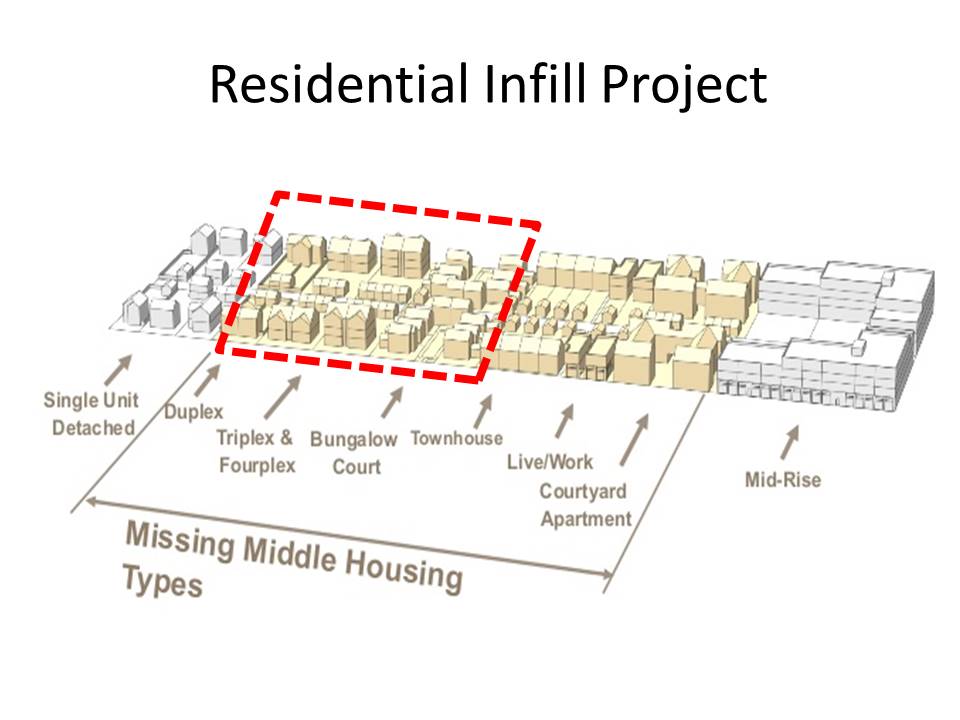What is this project about?
In response to community concerns about demolitions and the scale of new homes, as well as the supply of housing in Portland, the Residential Infill Project is exploring ways to adapt Portland’s single-dwelling zoning rules to meet the needs of current and future generations. The project addresses three topic areas: scale of houses, housing choice, and narrow lot development. For more information visit the project website at: www.portlandoregon.gov/bps/
With some fine-tuning, City Council approves Residential Infill Project Concept Report.
Legislative code and mapping phase to begin early 2017.
Legislative code and mapping phase to begin early 2017.
On December 7, 2016, City Council voted unanimously to approve a resolution that adopted the Residential Infill Project Concept Report with several amendmentsfrom the council. Council amendments were based on testimony they heard at their November 9 and 16 public hearings. Nearly 120 people testified in person, and Council received approximately 550 letters and emails during their review.
You may view videos of past City Council sessions at http://www.portlandoregon.gov/
What did City Council approve?
Council voted on a set of concepts that aim to discourage home demolitions while increasing housing choice in single-dwelling residential neighborhoods. During the public hearings Mayor Hales often asked testifiers if given the choice would they recommend 1) do nothing 2) modify staff’s recommendations or 3) start completely over. Most people responded that the recommendations were a good start but modifications were needed. Overall, Council agreed. Recognizing that the Concept Report gave general policy direction and guidance for staff to develop code and mapping proposals, Council made several modifications before they accepted the concept recommendations. Below is a summary of the council’s amendments by topic area:
SCALE OF HOUSES
- In an effort to reduce 1:1 demolition replacements (e.g. demolitions of a house that result in only one house being built), council voted to reduce the size of single-dwelling houses in the Housing Opportunity Overlay Zone (for example, from 2500 to 2000 square feet of living space on a 5000 square foot lot) while maintaining the same size limit for duplexes, duplexes and ADUs and triplexes on corners as what would be allowed for a single house outside the overlay (e.g. 2500 square feet on a 5000 square foot lot). Commissioner Novick expressed that he would like to see the size limits on duplexes and triplexes continued to be studied to ensure that resulting unit sizes were reasonable but there was no official amendment.
- Council approved several amendments introduced by Commissioner Fritz addressing flexibility for tree preservation, increasing private open space areas and reducing impervious surfaces.
HOUSING CHOICES
- Council did not revise the range of allowed housing types in the Housing Opportunity Overlay Zone (house with both internal and detached accessory unit (ADU), duplex, duplex with ADU, triplex on corner). However, they did direct staff to explore requirements and bonus unit allowances for age-friendly housing, affordability, and additional tree preservation.
- To encourage house conversion over demolition, the council voted to allow an additional unit when an existing house is converted into multiple units citywide (staff had recommended this bonus unit only in the Housing Opportunity Overlay Zone). Council also expressed the need to clearly distinguish an “internal conversion” from a near demolition and rebuild.
- The council did not vote on the conceptual boundary criteria for the Housing Opportunity Overlay zone, but rather asked staff to come back early next year with mapping options. They cited issues around where it should be, how far from frequent transit, and if the David Douglas School District should be exempt because of student capacity issues. They also voted to ensure that transportation infrastructure constraints were added to the list of mapping considerations.
NARROW LOTS
- Council rejected staff’s recommendation to rezone historically narrow lots to R2.5, and instead voted for an amendment to not allow individual R5 zoned historically narrow lots to be built on – even when they have been vacant for more than 5 years, as presently allowed.
- Council also voted to remove staff’s recommendation that front-loaded garages not be allowed on detached houses on narrow lots, as these will be less common as a result of the change to not allow houses on R5 historically narrow lots (narrow lots already zoned R2.5 zone will continue to be allowed).
For more detailed information on the approved concepts and the council amendments staff has prepared a matrix of the approved recommended concepts and the city council amendments.
Next Steps
The adoption of the Concept Report sets the stage for the next phase of the Residential Infill Project: code writing and map amendment proposals. Council’s vote directs staff to develop the code language and map amendments needed to implement the concepts in the report. This phase, beginning early 2017, will include public review of a discussion draft, followed by public hearings at the Planning and Sustainability Commission and City Council before final adoption by City Council. For general information about the project, visit the website at www.portlandoregon.gov/bps/
Questions? Contact Project Staff
Morgan Tracy, Project Manager, morgan.tracy@
Julia Gisler, Public Involvement, julia.gisler@
Julia Gisler, Public Involvement, julia.gisler@
